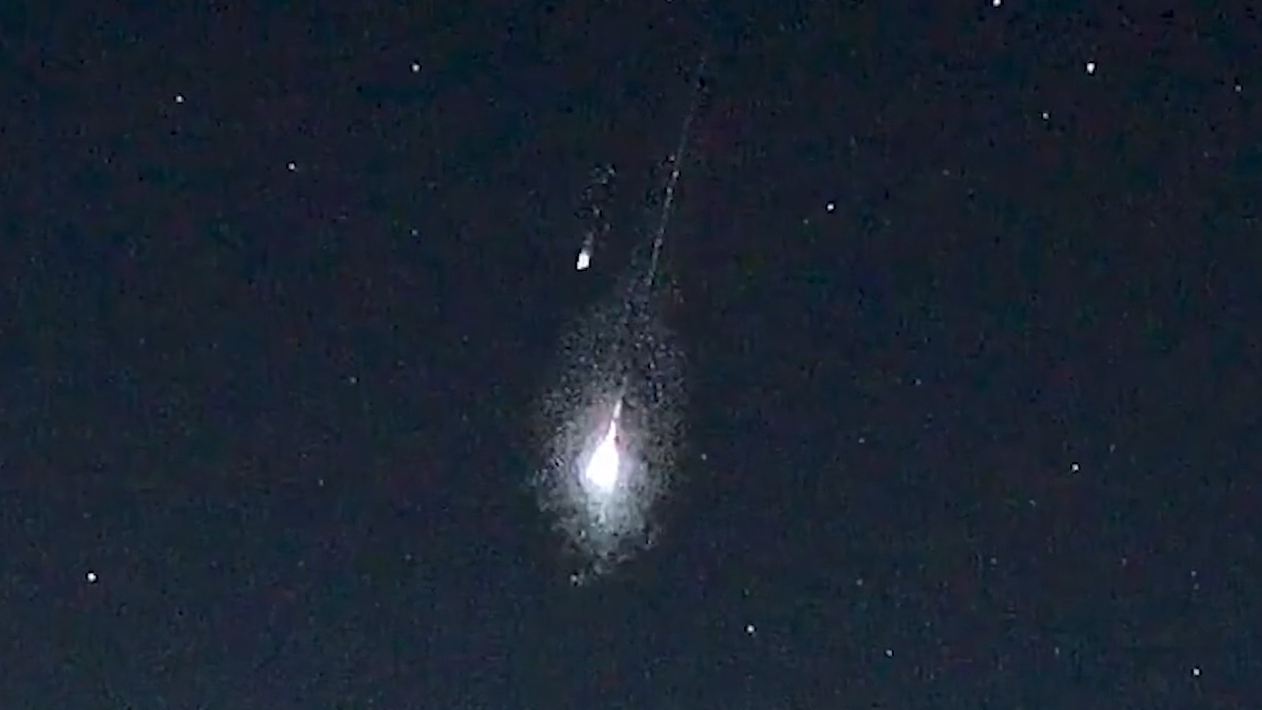Solar Eclipse Mostly for Penguins
On Feb. 7 the sun will undergo an eclipse that few will see.It will be an annular eclipse, a "penny on nickel" effect in whichthe moon will be too small to completely cover the disk of the sun.
The result will be the sun mimicking a blazingring of fire — hence the term "annular," derived fromthe Latin anularis which means"ring." It will certainly be an unusual and spectacular sight, but onlya very few people (and perhaps some penguins)will see it.
The region of visibility, if you haven't already guessed, is Antarctica, the only continent in the world with nopermanent or indigenous human inhabitants. Larger than the United States, this frozen land is populated by approximately 2,500 people during thesummer and fewer than 1,000 in the winter.
Eclipse in a freezer
A solareclipse is visible wherever the shadow of the moon strikes the Earth. Actually,there are two shadows, the outer shadow, called the penumbra, from where apartial eclipse can be seen, and the darker umbra or central shadow from wherethe moon completely blocks the sun and the grand spectacle of a total eclipsecan be observed.
A popular nickname for Antarctica is "thefreezer." And it is over that part of Antarctica known as Ellsworth Land that the central axis of the Earth's shadow will make its landfall at 3:20UT on Feb. 7. But it's not the umbra that will pass over this frozen wasteland,for the moon is 238,200 mi (383,350 km) away. As a consequence, the cone-shapedumbral shadow is shorter than that, so the tip of this dark shadow cone ends upfalling about 9,400 mi (15,100 km) short of touching the Earth's surface.
This negative-shadow or ?antumbra?— from where the solar annulus or ?ring of fire? effect may be seen— projects onto the Antarctic landscape somewhat in a shape resemblinga stubby cigar, and measures roughly 360 mi (580 km) along its longest axis. Itquickly will sweep over the Ellsworth Mountain range, the highest in Antarctica.Here also is Vinson Massif, 16,066 feet (4,897 meters) constituting the highestpoint on the continent. The antumbra arrives here at 3:24 UT.
Breaking space news, the latest updates on rocket launches, skywatching events and more!
At 3:30 UT, the antumbra makes its closest approachto the geographic South Pole, passing less than 800 mi (1,300 km) away to theeast. Curving away to the northwest, the antumbra then sweeps across Marie ByrdLand, a region ofwestern Antarctica east of the Amundsen Sea. Discovered and claimed for the United States by Richard E. Byrd in 1929, he named it in honor of his wife. However, due toits remoteness, even by Antarctic standards, most of Marie Byrd Land has notbeen claimed by any sovereign nation, making it by far the largest singleunclaimed territory on Earth.
An extreme eclipse cruise
Finally, at 3:39 UT, as the antumbra starts to slide off ofAntarctica and out into the Pacific Ocean, it will pass almost directly overthe Russkaya Antarctic research station which originally opened on March 9,1980, but was mothballed on March 12, 1990. However, according to ValeriyLukin, the head of the Russian Antarctic Expedition (RAE), a research ship departed Melbourne, Australia on Jan. 16 and will be at the Russkaya station from Feb. 5 to 9.
This station is located in the Pacific sector of Antarctica, which is poorly covered by scientific studies. An automaticweather station and GPS station will be installed at Russkaya. So as theantumbra departs Antarctica, perhaps those few intrepid scientists on boardthis research vessel will bear witness to the ringed sun.
Looking low to the west-southwest during this last fullmonth of Antarctic summer, they will see (weather permitting) the midnight sundescribing a shallow arc across the sky from right to left, almost scraping thesouthern horizon at its lowest point. But on Feb. 7, the silhouette of the new moonwill move onto it from the left and manifest itself as a black mask, eventuallycovering all of the sun save for a brilliant ring. Those few scientists onboardwould be looking along a line which makes nearly a tangent to the Earth, thendeparts from it into space and reaches the tip of the umbra; light from the rimof the sun will stream down either side of the umbra to reach their eyes.
The duration of the ringphase at Russkaya will last 2 minutes 8 seconds.
Partial eclipse down-under
By this time, the outer penumbral shadow has plodded to thenortheast encompassing New Zealand, Tasmania and the eastern quarter of Australia. The latter two regions will see less than one-quarter of the sun's diametercovered by the moon; New Zealanders however will see a more substantialobscuration, with the moon reaching roughly three-fifths of the way across thesolar disk. Here, about halfway up in the northwest sky, the moon will appearto quickly move in from the sun's left edge and about an hour later at around5:45 p.m. local time (give or take some minutes depending on the location) the sunwill resemble a fat crescent, with cusps pointed up and a large chunk of itsupper portion eclipsed.
The penumbra also reaches up to touch some of the south Pacific Islands that are scattered to the north, such as New Caledonia and the Republic of Vanuatu. At 4:31 UT the antumbral shadowhas slipped off of the Earth, followed one hour and 41 minutes later by thelast edge of the penumbra departing the Earth and the last slight scallop inthe setting sun might be seen to the north of Mata'utu, Wallis and Futuna Islands.
A listing of local circumstances for selectedlocations within the eclipse zone can be found here.
- HowSolar Eclipses Occur
- Gallery:Solar Eclipse of 2005
- SolarEclipse Facts
Joe Rao serves as an instructor and guest lecturer at New York's Hayden Planetarium. He writes about astronomy for The New York Times and otherpublications, and he is also an on-camera meteorologist for News 12 Westchester, New York.
Join our Space Forums to keep talking space on the latest missions, night sky and more! And if you have a news tip, correction or comment, let us know at: community@space.com.

Joe Rao is Space.com's skywatching columnist, as well as a veteran meteorologist and eclipse chaser who also serves as an instructor and guest lecturer at New York's Hayden Planetarium. He writes about astronomy for Natural History magazine, Sky & Telescope and other publications. Joe is an 8-time Emmy-nominated meteorologist who served the Putnam Valley region of New York for over 21 years. You can find him on Twitter and YouTube tracking lunar and solar eclipses, meteor showers and more. To find out Joe's latest project, visit him on Twitter.
